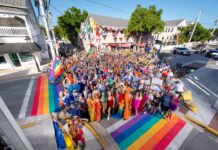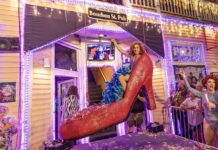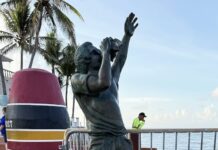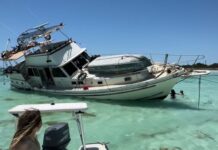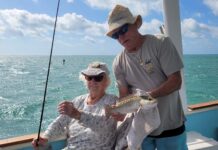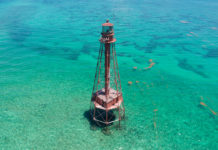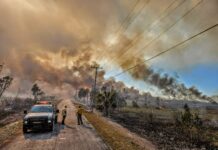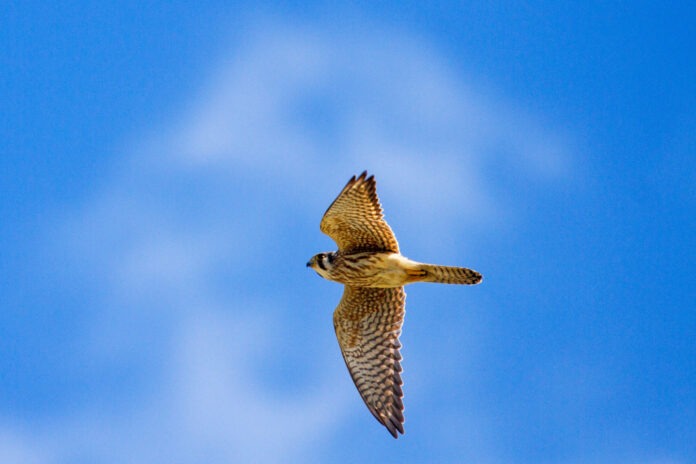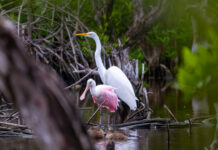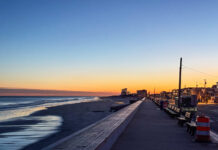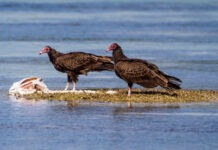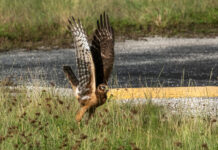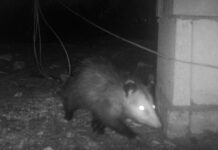It had been a few weeks of visiting with family and friends up in the northlands, but it was time to head home, though maybe not directly. My first stop was the Cape May Bird Observatory’s hawkwatch platform, at the southern tip of the New Jersey peninsula, across a large parking lot from the iconic Cape May Lighthouse.
If you’re used to smaller hawkwatching sites, such as the Florida Keys Hawkwatch, the Cape May platform can be a bit of a culture shock. There were about 40 people there when I arrived on a Monday morning, but on peak weekends, up to 1,000 people will show up. It can be tough for a counter to keep an eye on the migrating birds when there’s a crowd, so the CMBO tends to deploy an official counter on the upper level of the deck, concentrating on the skies and what’s moving through them, and a naturalist or two down below, to interact with visitors, pointing out birds, answering questions and generally working like an emcee for the spectacle of visible live-before-your-eyes migration.
The platform is not oriented toward the parking lot, of course, but to the north, over a lush and storied marsh with a pond full of ducks, geese and swans. It was windy, and a cloud of swooping tree swallows wove the complicated patterns of invisible fabrics overhead. There were also a few sizable Vs of white ibis, a species common in Florida but not seen much in New Jersey until five or so years ago. And there was a steady feed of raptors – broad-winged hawks, northern harriers, turkey vultures, American kestrels and merlins. It would get much busier in the coming weeks, but it was a damn pleasant way to spend an hour or so before catching the ferry to Lewes, Delaware.
On the ferry I was directed to park about six inches behind the next car. I made it up to the top deck just as the lines were thrown and the ferry began to move.
It was mostly cloudy, with a sliver of silver light gleaming on the surface of the water most of the way. I was hoping to catch sight of one of the raptors crossing the bay – a merlin, a northern harrier, an American kestrel. But it was mostly great black-backed gulls, herring gulls and ring-billed gulls.
Something about leaning against the bulkhead with a pair of binoculars gave people the idea I was interested in small talk, though, and I was taught not to be rude.
There was an older woman down on the car deck staring out ahead, and a guy from Kentucky asked me if I thought there was an older woman staring out ahead on the car deck on every trip, because he’d seen another older woman standing there doing the same thing in the same place when he’d crossed over that morning. A little while later, a guy wearing an orange tie-dyed shirt told me about how they’d put a chain across the Hudson River during the Revolutionary War to keep the Brits out.
It wasn’t a particularly rough trip, but when we passed by the breakwater on the Delaware side, a man in a long-sleeved blue shirt came out of nowhere to tell me the ride would be much smoother now that we had passed the breakwater. I realize women experience mansplaining far more often than men, but still. Also, I kind of missed the waves.
My sister Karen had mentioned a hawkwatch site at Cape Henlopen State Park, which was five minutes from the ferry landing, so I headed there. The platform was up a long flight of wooden steps on top of an old World War II bunker. The count crew looked to be gone for the day, but the views of the ocean and the waves crashing on the almost empty beaches were epic.
There’d been a guy in khakis and a dress shirt milling about on the grass on top of the bunker, and he came up onto the platform a few minutes later, and said he forgot his binoculars.
I scanned the ocean for a while and tracked an osprey flying upwind just over the breakers, salt spray flying all around him. The guy in khakis kept trying to make small talk about several subjects, one being his friend’s belief that the earth was flat.
He was wearing wraparound sunglasses, so I couldn’t see his eyes, but I was beginning to get a vibe. I didn’t think he was cruising me, and I didn’t quite think he wanted to mug me, but he wanted something. Money? A ride? Investment in a multi-level marketing scheme?
Finally he said, “Do you know about the Mighty One who created the lands and the seas?”
I gave him an answer that may have belied my raised-to-be-polite upbringing, and decided to move on out of the awkwardness of it all a few minutes later.
I made it to the Kiptopeke hawkwatch site at the south end of Delmarva Peninsula late the next morning. It’s the last fully staffed hawkwatch before ours in Marathon. Fifteen minutes before I got there, a front came in, dropping down a blinding deluge. The Florida Keys Hawkwatch usually counts rain or shine, unless there’s a hurricane, so I went to the site just in case, but it looked like they’d given up for the day.
I drove around the peninsula for an hour or two, waiting for the rain to stop. When it finally did I was sitting at a boat ramp, contemplating my next move. A merlin flew overhead and shot out over the marsh with a go-for-broke speed and intensity that made me think he was aiming to cross the 19-mile-wide mouth of the Chesapeake right then. I took it as a sign.
I decided to drive along one more country road before I headed for the bridge-tunnel, just in case. And I’m very glad I did. It was a small falcon jamboree. Over a distance of about two miles I saw at least 50 American kestrels and about two dozen merlins. They were in pretty much every tree and on every utility line I passed. They’d all been waiting out the storm, waiting for the weather to be clear enough for them to cross.
When I pulled up to pay the toll for the Chesapeake Bay Bridge-Tunnel, the woman in the booth looked into my car and asked what I was taking pictures of with such a big lens. “Birds,” I said. “What kind of birds?”
I said, “Falcons, mostly,” and she said, “It’s that time of year.”
I told her about the road with merlins and kestrels in almost every tree and on almost every power line. She said she didn’t know merlin sat on telephone wires. I said, “They did today.”
She knew quite a bit and we talked about birds and how geography shaped their paths and a few other things for a few more minutes. We probably would have kept going, too, if a blue Peterbilt hadn’t pulled into line behind me and filled up my rearview mirror. It seemed best to move on.
